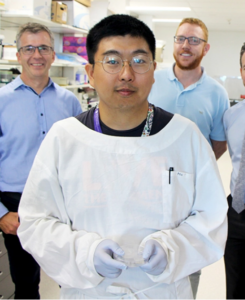A state-of-the-art livecyte microscope at the Griffith Institute for Drug Discovery is leading the Spinal Injury Project team toward human clinical trials.
In a celebration of cutting-edge research and technological innovation and thanks to an incredible donation by the Perry Cross Spinal Research Foundation, The Honourable Dame Quentin Bryce AD CVO, Hon DUniv (Griffith), unveiled the Phasefocus2 Livecyte microscope and plaque.
The microscope represents a significant advancement in scientific instrumentation and is set to revolutionise the Spinal Injury Project undertaken by the Clem Jones Centre for Neurobiology and Stem Cell Research at Griffith University.
It will enable the research team to perform critical cell analysis and screening procedures, a crucial step toward the cell transplantation and rehabilitation human clinical trials commencing shortly.
The clinical trial aims to test cell transplantation therapy to repair spinal cord injury, ultimately leading to the restoration of function.

Professor James St John
Professor James St John said the advanced microscope is new to the market and offers the capability to track the fate of each cell through high-resolution live cell imaging.
“Livecyte allows for the identification of any cells exhibiting abnormalities or likely to cause complications such as tumour formation,” he said.
“By screening the cells that are prepared for the patient, and ensuring the cells are healthy, we can decrease the risk of adverse events for the patients.
“The livecyte microscope will play a pivotal role in ensuring the safety of the cells used in the transplantation process.”
Griffith’s partnership with the Perry Cross Spinal Research Foundation has already led to many milestones including:
- transformational research initially conducted by Emeritus Professor Alan Mackay-Sim;
- development of the 3D nerve bridge for transplantation;
- successful outcomes of the intensive rehabilitation trials; and
- now being on the cusp of the first ever human clinical trial utilising these research outcomes.
Foundation founder, Perry Cross AM, said it has been invaluable having such a close relationship with Griffith, who specialise in the new technology.
“There have been many people, even specialists in the industry saying ‘it won’t work, it’ll fail, these types of trials don’t get off the ground because people won’t commit’, but by all reports we’ve been very, very successful so far,” he said.
“I’ve been leading the charge from a patient perspective and the community of people we have at the foundation with spinal cord injury, as well as their family and friends, are all here saying ‘we believe in this so let’s do it’.
“It’s been my ultimate goal since setting up the organisation in 2010 to start human trials, so it will be so great to that get started.
”Additionally, the Perry Cross Spinal Research Foundation partnership made possible the awarding of a Postdoctoral Fellowship to Dr Mo Chen, a Fellow of the Clem Jones Centre for Neurobiology and Stem Cell Research for the past four years.

Dr Mo Chen
Dr Chen obtained his Bachelor of Biomedical Sciences degree with first class honours at Griffith in 2015 before commencing his PhD researching the use of natural products and the use of glial cells for neural repair, graduating in 2019.
Since then, he has been successful in attracting considerable research funding including being lead investigator on a Medical Research Future Fund early career/mid-career grant with a total project value of $1.5 million, with funding partners the Perry Cross Spinal Research Foundation, the Clem Jones Foundation and Griffith University.
An outstanding early career researcher, he invented a powerful technology to generate cellular nerve bridges for repairing injuries of the nervous system, which has been central to his team’s success in generating the therapy for spinal cord injury.
Dr Chen said the postdoctoral fellowship would allow him to delve deeper into his research and further explore related topics.
“I aim to explore new research directions, address cutting-edge issues and make meaningful contributions to academia and society,” he said.
“I will continue to collaborate with mentors and colleagues to advance my research agenda and strive to publish high-impact research papers, continuously learning and improving to ensure my research keeps pace with the latest developments in the field.”

